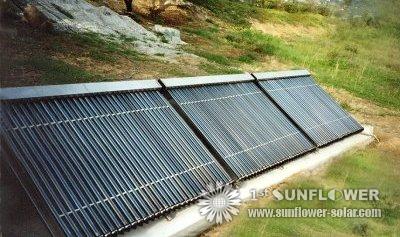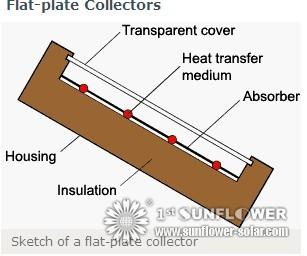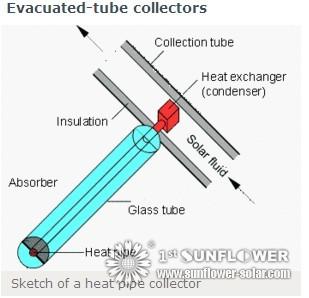Solar collectors: Types and application areas
Author:None
From:None
Post time:04/19/2012
View:2780
Solar collectors transform solar radiation into heat and transfer that heat to a medium (water, solar fluid, or air).
Solar collectors transform solar radiation into heat and transfer that heat to a medium (water, solar fluid, or air). Then solar heat can be used to heat water, to support the heating systems, or for heating swimming pools.
The use of solar heat

The heart of a solar collector is the absorber, which generally consists of several narrow strips of metal. The carrier for the heat transfer fluid flows through a pipeline that transports heat, which is connected to the absorbent Strip. In the absorber plates, two sheets are interspersed together allowing that the medium to flow between the two plates. Absorbent are typically made of copper or aluminum.
Swimming pool absorbers, on the other hand, are usually made of plastic (mainly EPDM, but also of polypropylene and polyethylene), as the lowest temperatures involved do not require a higher heat capacity.
Heating and storage come together in a collector tank. Deposit collectors matrices do not need bombs movement or adjustment mechanisms, as drinking water is heated and is stored right on the manifold.
Highly efficient absorber surfaces
Absorbers are usually black, dark surfaces show a particularly high degree of light absorption. The absorption level indicates the amount of solar shortwave radiation is absorbed which means not be reflected. As the absorber is heated to a temperature above the ambient temperature, a large part of the solar energy accumulated in the form of long-wave heat radiation it emits. The relationship between the energy absorbed in the heat emitted is indicated by the emission factor.
In order to reduce energy loss through heat emission, the most efficient absorbers have a selective surface coating. This coating enables the conversion of a high proportion of the solar radiation into heat, simultaneously reducing the emission of heat.
surface coating. This coating enables the conversion of a high proportion of the solar radiation into heat, simultaneously reducing the emission of heat.
The usual coatings provide a degree of absorption of more than 90%. Solar paintings that can be mechanically applied to the absorbent (either with brushes or sprays), are less or nothing at all selective, since they have a high level of emission. Electrically applied selective coatings include black chrome, black nickel, and aluminium with nickel oxide. Relatively new is a layer of nitride of titanio-oxido, which is implemented by steam in a vacuum process. This type of coating is notable not only for its emission rates very low, but also because its production is free of emissions and energy efficiency.
A flat plate collector consists of an absorber, a transparent cover, a framework, and isolation. Generally speaking, a solar hierro-pobre of safety glass is used as a transparent cover, which transmits a large amount of the light of short-wave spectrum.
At the same time, only very little of the heat emitted by the absorber is leaking from the cover (greenhouse effect).
In addition, the transparent cover avoids that wind and breeze to carry the heat collected from distance (convection). Together with the frame cover protects the absorber of adverse weather conditions. Typical materials include aluminum and galvanized steel frames, sometimes with plastic-reinforced fiberglass is used.
The insulation on the back and on the side walls reduces heat loss by conduction. The insulation is usually mineral wool or polyurethane foam although insulating mineral fibre material such as glass wool, rock wool, fiberglass or fiberglass are sometimes used.
The collectors show a good relationship price/performance, as well as a wide range of possibilities (ceiling mount, ceiling, or not linked).
In order to reduce the loss of heat within the framework by convection, air can be pumped out collector tubes. These collectors can call evacuated tube collectors. It should return to evacuate once every one to three years.

In this type of manifold vacuum, absorbent Strip is in a tube of evacuated glass and the test pressure. The heat transfer fluid flows through the absorber directly into a tube in U or Backwashing on a system of tube in tube. Number of individual tubes, interconnected series or interconnected through the collector tubes make up the solar collector. A heat pipe collector incorporates a special fluid that begins to vaporize even at low temperatures. Steam rises in the individual heat pipes and heats the carrier fluid in the main line by means of a heat exchanger. The condensate then flows towards the base of the heat pipe.
The tubes must be at an angle to a specific degree above horizontal so that the process of vaporizing and condensing functions. There are two types of connection of the collector on the solar circulation system. Either the heat exchanger extends directly into the manifold ("wet connection") or that is connected to the manifold by a heat-conducting material ("dry connection"). A "dry connection" allows the exchange of individual tubes without draining the whole system of its fluid. Evacuted tubes offer the advantage that work efficiently with high absorption temperatures and low radiation. Higher temperatures can also be obtained for applications such as hot water heating, steam and air conditioning supply.
How much energy does a solar collector provide?
 The efficiency of a solar collector is defined as the quotient of usable thermal energy versus received solar energy. Besides thermal loss there alwas is optical loss as well. The conversion factor or optical efficiency h0 indicates the percentage of the solar rays penetrating the transparent cover of the collector (transmission) and the percentage being absorbed. Basically, it is the product of the rate of transmission of the cover and the absorption rate of the absorber.
The efficiency of a solar collector is defined as the quotient of usable thermal energy versus received solar energy. Besides thermal loss there alwas is optical loss as well. The conversion factor or optical efficiency h0 indicates the percentage of the solar rays penetrating the transparent cover of the collector (transmission) and the percentage being absorbed. Basically, it is the product of the rate of transmission of the cover and the absorption rate of the absorber.
The specific costs of collectors are also important. Evacuated-tube collectors are substantially more expensive (at 511,29 - 1278,23 Euro /m² collector surface) than flat-plate collectors (153,34 to 613,55 Euro /m²) or even plastic absorbers (25,60 to 102,26 Euro /m²). However, a good collector does not guarantee a good solar system. Rather, all components should be of high quality and similar capacity and strength.
Text and graphics by permission of the:
Deutschen Gesellschaft für Sonnenenergie e.V -- German Society for Solar Energy.
Concise and comprehensible explanations of the basic concepts in solar heating and photovoltaics can be found in our Solar-Lexicon.
Reports on technology, business and politics, as well as presentations on innovative systems and products can be found in the Solar Magazine
surface coating. This coating enables the conversion of a high proportion of the solar radiation into heat, simultaneously reducing the emission of heat.
The efficiency of a solar collector is defined as the quotient of usable thermal energy versus received solar energy. Besides thermal loss there alwas is optical loss as well. The conversion factor or optical efficiency h0 indicates the percentage of the solar rays penetrating the transparent cover of the collector (transmission) and the percentage being absorbed. Basically, it is the product of the rate of transmission of the cover and the absorption rate of the absorber.